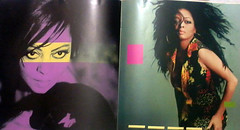
Diana Ross had spent the sixties touring with the Supremes, the seventies solo, the eighties solo and the nineties solo. In doing so, she'd become one of the few female artists that could hit the road and pack in an audience. James Taylor would be the male equivalent but people pay a lot more for a Diana concert. Maybe because she had a lot more hits?
41 singles on the Hot 100, 51 songs on the R and B 100, 30 hits on the AC top 50, and 18 hits on the dance charts (including 1999's number two hit "Until We Meet Again"). All of these after she began her solo career. This was after she had sang lead on 25 top forty singles with her group the Supremes.
So in 1999, as she prepared for her 2000 tour, an idea from friend Scott Sanders to feature a Supremes segment in the new tour became an idea to bring on the Supremes. Diana wanted to bring all the living Supremes from after the trio of Diana, Mary Wilson and Florence Ballard first hit the charts. That would include Cindy Birdsong who replaced Florence, Jean Terrell and Lynda Laurence who joined the group in 1970 after Diana went solo, Scherrie Payne who replaced both Jean and Lynda and Susaye Greene who replaced Cindy Birdsong in 1976.
As usual, where there are good intentions with the Supremes, there is Mary Wilson, always lurking, always attempting to destroy. By this point in her sad life, she'd killed her 14-year-old son Rafael with her bad driving, rumors of alcoholism plagued her, a 'behind the scenes expert' was rumored to be her same-sex lover that Mary was allegedly desperate to keep hidden, and she was floating one check after another while desperately pleading for money from anyone who'd ever toured with her decades before.
While most -- including a famous songwriting team -- had long ago learned to hang up on her, Diana had always opened her purse to Mary -- including when Mary needed money to keep a house. Like Florence Ballard before her, Mary's had non-stop financial struggles. And the many decades since the sixties had not been kind to Mary who never found recording success as a solo act and who's only performances sold as sad nostalgia. Mary really needed the money -- almost as badly as twenty years before when she borrowed $30,000 from Diana to avoid being homeless.
So the idea of a tour with all the Supremes seemed like a winner.
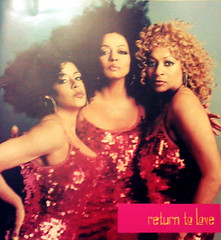
Diana made the deal with what is now Live Nation Entertainment and informed the various Supremes to contact them and work out details. The only detail that mattered to Mary was money and $500,000 for 30 concerts wasn't enough for Mary. That came to over $17,000 a concert and, no, Mary hadn't seen a payday like that before in her life. Live Nation finally offered Mary $2 million for 30 concerts. That would have been over $60,000 a concert.
It wasn't enough for her.
Mary Wilson, for those who don't know, sang briefly on recordings in the sixties. Due to her affairs with Tom Jones and others, Mary was often unavailable for scheduled recording sessions. Berry Gordy has been very kind over the years and worded that very carefully but that's why Berry began using backup vocalists. It was a lot quicker and a lot cheaper to just send two backup singers into the studio with Diana to record. Though she knew she didn't sing on, for example, the number one hit "Love Child," Mary was always quick to claim the money for it. Greed, more than anything explained Mary Wilson.
In 1970, Diana went solo and Jean Terrell replaced her as lead singer. The group scored six top forty hits over three years. From 1968 on, Mary had always (wrongly) thought that when Diana left the group, she would become lead singer. With Jean as lead singer, Mary began whining and griping about singing background vocals. This led to Mary sharing co-leads on singles and led to Jean leaving the group. (Jean Terrell also felt that when the group needed to be demanding Motown promote them more, Mary always caved to Berry and backed down.) When Jean left, there were no more big hits for the group. Scherrie Payne would join as a lead singer only to also experience Mary's "me too! I sing lead too!" nonsense. The only hit the group had with Scherrie was "I'm Gonna Let My Heart Do The Walking" which made it to number forty on the Hot 100.
Mary Wilson quit the group in 1977. She went on to pursue a solo recording career which consists of two studio albums -- 1979's Mary Wilson and 1992's Walk The Line -- which bombed. She could also be found in many Canadian provinces doing dinner theater. Outside of royalties from Motown for her time with Diana Ross and the Supremes, Mary rarely earned $40,000 most years.
So the amount of money she was turning down was huge.
Live Nation was negotiating with her. Diana had nothing to do with it. But when Diana learned Mary had said the $2 million was not enough, Diana offered to kick in $2 million out of her own pocket. Diana saw it as money paid to avoid continued aggravation and as a gift to the fans.
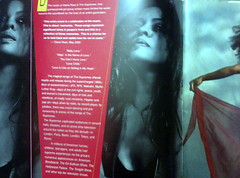
Four million dollars was now being offered to Mary Wilson. For 30 concerts. Over $130,000 a concert. A payday like she'd never seen before.
The thing with Mary is that her ego is stronger than her memory. Her memory sometimes forget that, for example, she fired Florence Ballard from the Supremes. In the meeting Berry called, Berry noted Florence had missed too many shows, had been on stage drunk and that this couldn't continue so she was out of the group. Florence's mother turned to Mary and said Mary wanted Flo to stay in the group. In her own first bad book, Mary writes that she said, "Mrs. Ballard, Flo doesn't want to be in the group anymore. Yes, I want her in the group but what can I do? She no longer wants us."
That's a cute way of avoiding saying, "You're fired." But it says "you're fired" just the same.
When Mary was having one of her many affairs and begging off work in the sixties, Berry warned her that she'd better work while she could because there would come a day where all the magic would be gone. Mary would have done well to remember that bit of advice.
She didn't. Besides, she was high on herself.
With all the drama she was causing, she was upstaging the planned tour itself. Reporters were calling her, Nightline wanted to do a segment with her.
Mary who was never famous in her own right ("Diana Ross and the two girls" is not fame) saw this as her big moment. Like a reality TV star mistaking headlines for a career, Mary plunged in, determined to destroy the tour.
So she passed on $4 million at a time when she desperately needed it. And she went to work destroying the tour.
Diana prepared to tour with Scherrie Payne and Lynda Laurence after Birdsong and Wilson passed. Mary immediately began insisting that this wasn't the Supremes!
Strange because, in the 70s, when Mary sang with the two women, they were billed as the Supremes, they recorded as the Supremes. Suddenly, they weren't good enough to be Supremes, according to Mary.
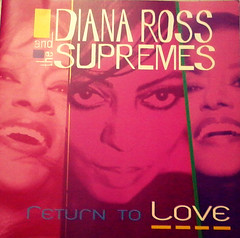
Return To Love, as the tour was known, was a gift for the fans. Especially the Diana fans who were tired of the Supremes medley in concerts. Diana has a huge catalogue of solo hits. It's so huge that she can't perform them all in concert. So when she covers her pre-solo career hits, it's generally done in a quick medley.
Suzanne dePasse's keen sense had once again saved Motown. While other sixties hits from the period tended to fade or re-emerge briefly, de Passe knew how to license and market an older hit. She did it in such a way that, for example, "Reflections" would find a whole new audience as the theme song to China Beach. These songs were still popular and were newly popular.
Return To Love would give the audience a chance to hear them live for the first time in over thirty years -- for the first time since Diana Ross and the Supremes' farewell performance in Las Vegas on January 14, 1970.
The show opened in Philadelphia and won a rave review from J.D. Considine (Balitmore Sun).
And that's because it was a great show. Solo, Diana performed a few of her number ones such as "Touch Me In The Morning" and "Ain't No Moutain High Enough," but the bulk of the show was the Supremes: "Reflections," "Come See About Me," "You Can't Hurry Love," "Baby Love," "Stop In The Name Of Love," etc.
At the start of the tour, during the final number ("I Will Survive"), Diana would bring a person on stage from the audience but, as the tour continued, it became a regular dance floor as people crowed onstage. Another thing that changed as the tour continued was Diana's interaction with the audience.
Unlike Barbra Streisand, Diana's never needed a telepromter at a concert and has never needed to have her words scripted for her. She can think on her feet and does. And as the concert continued, she spoke more and more outside of the inspirational moment -- where Diana would talk about how society has changed, MLK, etc. And during the non-inspirational part, people would sometimes shout at things (like "I love you!") or song requests. As the tour progressed, Diane would often turn to towards the band and ask if they knew the song or, more often, "Can we do that?" If the band started nodding, she started singing -- songs like "When The Lovelight Starts Shining Through His Eyes" and "Some Things You Never Get Used To."
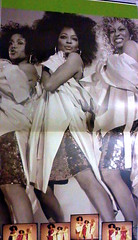
It was no longer a concert, it was an event or, to borrow from a 1968 number one hit, a "happening." It was Diana at her most relaxed, it was Scherrie and Lynda providing some strong vocals (as well as taking a lead turn themselves). It was the audience up on its feet dancing.
And Mary continued attempting to destroy it.
Halfway into the tour, it got the axe. The sold out show in Madison Square Garden would be the last. Live Nation swore that ticket sales weren't there. A rather dubious claim since the NYC concert would be heavily reported on and lead to sales in other markets. A rather dubious claim because Diana was willing to complete the tour at a personal loss. (But not willing to agree to give Live Nation her next two tours. When she said no to that, Live Nation axed the tour.)
For fourteen shows, Return To Love grabbed audiences and made memories.
That alone would qualify it as the tour of that decade. But the other thing, the lies of Mary Wilson and how they were allowed to take over reality?
That also makes it the tour of the decade.
Remember, this was the decade when the Bully Boy Bush administration would sell an illegal war with lies. Just like Mary helped kill a successful tour with lies.
So it's only fitting that Return To Love be the tour of the '00s -- just as it was fitting that Mary Wilson enlisted in the Bush administration becoming its "culture ambassador." Reportedly in Mozambique and elsewhere, the most asked question of Mary was, "What's Diana Ross like?" We see that as fitting as well. (After all, it would have been rude to ask Mary, "Who are you, again?")
---------
All illustrations are from the tour booklet which was the size of a vinyl album cover and contained many amazing photos.
